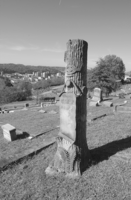 | Back to e-WV
| Back to e-WV
 The West Virginia Encyclopedia
The West Virginia Encyclopedia
 | Back to e-WV
| Back to e-WV
 The West Virginia Encyclopedia
The West Virginia Encyclopedia

Customs change with the passage of time. As early settlers spread into sparsely populated remote regions and away from established cemeteries, small family graveyards became common in Western Virginia. Churchyard cemeteries remained common in settled villages and towns. Today, depending on locality, West Virginians are still buried in family graveyards and in churchyards, but more often in large commercial cemeteries. Some are buried in cemeteries maintained for veterans or for members of fraternal organizations, and others in municipal cemeteries. Cremation, although increasing, remains less popular here than in the country as a whole.
Elements of our culture are on display in West Virginia’s cemeteries. Gravestones commonly face east, the direction from which Christians believe the resurrection will come. Cemeteries often contain a yew or a cedar tree, evergreens that symbolize eternal life. Family graveyards are most commonly located on a hill or other high point, a cultural preference for reasons not entirely clear. Perhaps it was to put the departed above the fray of everyday affairs and nearer to heaven, or, as the poet Louise McNeill mischievously suggested, to use marginal land fit only for raising a crop of graves.
Formal cemeteries are often laid out according to impressive plans prepared by landscape architects. There was a movement in 19th-century America to establish park-like public cemeteries, with extensive grounds and impressive monuments. Charleston’s Spring Hill and Wheeling’s Greenwood are fine examples of such garden cemeteries in West Virginia. Churchyard burial grounds are organized less formally than these great Victorian cities of the dead, while family graveyards just seem to grow. In the latter, the graves of succeeding generations often gather around those of the founding patriarchs and matriarchs. It is a naturally pleasing arrangement, replicating in death the family circle that prevailed during the lifetimes of those now gone. Topography also plays a role in family graveyards, which usually follow the lay of the (often rugged) land.
Gravestones characterize cemeteries of every sort and convey much cultural information. Many of the oldest grave markers were fashioned by local semiskilled artisans from fieldstone. These markers may still be observed today, but the degree of weathering varies with the geology of the locale and the durability of available stones. By the early to mid-19th century, skilled regional stonecutters were at work providing markers. Gravestones from this period demonstrate individual artistic mastery as well as regional, cultural, ethnic, and personal values displayed in symbolic ways.
By the end of the 19th century, gravestone production became less regional and more commercial. Transportation allowed hard, durable marble and granite to be delivered to tombstone manufacturers from far away. As a commercial business, the after-life process from death to interment to permanent recognition through a grave marker became increasingly depersonalized. Today, with perpetual-care facilities being yet another option, after bereavement and mourning little further attention need be given by surviving family members. In contrast, the graves and graveyards of earlier days were kept up by family and friends, whose attention might be intensely personal and even a source of anxiety to those approaching death. An old traditional song titled ‘‘See that My Grave is Kept Clean’’ reflected this anxiety. No one wants to lie in a lonely, forgotten grave.
Even after the commercialization of burying, much traditional symbolism may be observed in grave markers. The religiously symbolic praying hands, a small lamb (for a child), an anchor, a weeping willow, or a broken chain demonstrate typical parting emotions evoked in three dimensional form. Around the turn of the 20th century, full-sized stone tree trunks, some carved in West Virginia, found favor with woodsmen and others. These often feature certain plants growing at their bases, such as ferns and ivy, to symbolize everlasting life.
With the increased interest in genealogy, old cemeteries are now getting more attention and renewed respect. Cemetery surveys have been done for many counties, locating cemeteries and mapping them to identify occupants. Community volunteers and local historical societies often perform this work. Some ancestors are honored with newly made markers to replace rough fieldstones or weathered headstones. When all is said and done, the most lasting artifacts to survive into the future to represent a common person’s life on earth are the grave markers placed to mark their final resting place in cemeteries.
Written by Gerald Milnes
Crissman, James K. Death and Dying in Central Appalachia. Urbana: University of Illinois Press, 1994.
Little, M. Ruth. Sticks and Stones: Three Centuries of North Carolina Gravemarkers. Chapel Hill: University of North Carolina Press, 1998.
West Virginia Cemeteries, Calendar. State Historic Preservation Office West Virginia Division of Culture & History, 2004.